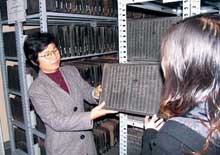 The wood blocks, submitted for recognition last January, are part of a collection of nearly 35,000 dating from 1697 -1945 used to print literary and historical works. If the entire collection were printed, they would make 152 books, according to the document submitted to UNESCO.
The wood blocks, submitted for recognition last January, are part of a collection of nearly 35,000 dating from 1697 -1945 used to print literary and historical works. If the entire collection were printed, they would make 152 books, according to the document submitted to UNESCO.The collection is now being preserved in the State Records and Archives Department at National Archives Centre 4.
Apart from their historical value, marking the development of the wood block carving and printing profession in Vietnam, the wood blocks also are important in terms of their art and skill.
The blocks are of solid wood with letters carved in Chinese or ancient Vietnamese. The letters are carved in reverse so that when the image is printed, it will appear the right way round.
The blocks represent an important part of the country’s feudal history. Under the Nguyen Dynasty, they were used to print posters publicizing social standards, articles on the lives and careers of the aristocracy and historical records. These were original records of the time and it is for this reason that they are considered so valuable to the nation.
The collection boasts many rare and valuable wood blocks, including Dai Nam Nhat Thong Chi (History of the Unification of Great Vietnam) and Dai Nam Thuc Luc (Royal Annals of Great Vietnam).
Most of the wood blocks are made of thi tree wood which is yellow and soft, or wood from the nha dong tree, which is smooth and an ivory colour. These kinds of wood are especially good in preserving the shape of the carvings.
Along with Vietnam’s contributions, another 34 nominations from around the world have been accepted as Memory of the World. These include the diary of Anne Frank, the famous Dutch teenager who was killed by the Nazis, a document on slaves in the Caribbean when it was a British colony between 1817 and 1834, artworks by Canadian artist Norman McLaren and some royal Thai documents.
UNESCO launched the programme of World Memory in 1994 to guard against collective amnesia and to call upon the preservation of valuable archive holdings and library collections all over the world ensuring their wider dissemination.
To date, 193 pieces of heritage have been recognised worldwide.